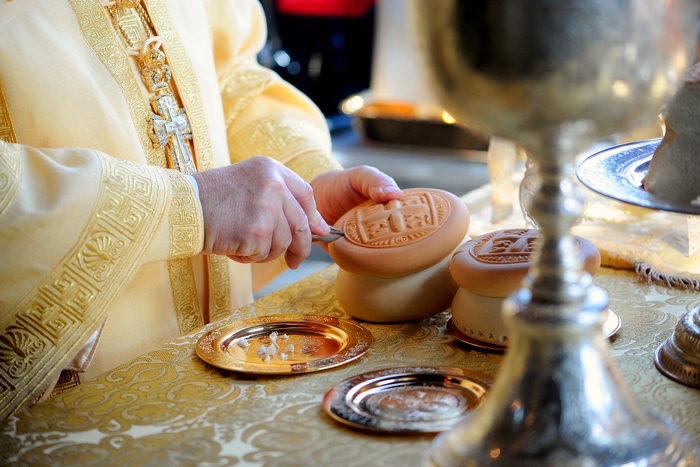
Panagia is a medallion-shaped pectoral icon acting as a distinctive sign of the episcopal dignity. Typically it depicts the Lord, the Mother of God or, less commonly, the Holy Trinity, Crucifixion, a particular saint or a Biblical subject. Panagias are worn by patriarchs, metropolitans and bishops in the same way as pectoral crosses are worn by priests over their cassocks. This hierarchical attribute has its own history and symbolism.
History of Appearance
In the Middle Ages, monastics as well as lay Christians in Greece and Russia wore on their chests small reliquaries on laces or chains. These reliquaries were called encolpia and were decorated with images of Christ, the Mother of God, and saints. Their shape was rectangular, rounded, or cruciform. These reliquaries were used for keeping holy relics or parts of the Panagia prosphoron from which a particle is taken out during proskomedia in honor and memory of the Mother of God.

From ancient times, a custom has existed in monasteries called the Lifting of the Panagia during which the panagia prosphoron was ascended with special prayers before icons. It was then crushed into particles, and the brethren ate of it. It was associated with the appearance of the Mother of God to the holy apostles on the third day after Her Assumption. At the end of the meal, they intended, as usual, to break a loaf of bread in honor of Jesus Christ, and suddenly saw the Most Holy Theotokos, who joyfully greeted them. Then, instead of turning to the Lord, they exclaimed: “Most Holy Theotokos, help us!” After this occasion, the apostles (and later many monastics and pious laity) would begin their meals with commemorating Christ, and end them with honoring the Mother of God. For this purpose the Panagia prosphoron was transferred from the church to the refectory using encolpia. The Queen of Heaven and the prosphora in Her honor have long been called Panagia (Greek: the All-Holy). The encolpion used for transferring the Panagia prosphoron or holy relics was initially called the panagiaron, but this name was replaced over time by the term panagia.
St Simeon of Thessaloniki (15th century) was the first to mention panagia as an obligatory attribute of a bishop, given to him at consecration. In the 17th century the writer Jacob Gohar testified that upon accepting the omophorion, the bishops of the Greek Church received an encolpion in the form of a precious cross with relics of saints. Eventually this Eastern custom was absorbed by the Russian Church.
By that time, panagiara were already widespread in Russia in the form of rectangular reliquaries with images of the Lord, the Theotokos and the saints. Gradually their shape transformed from rectangular to a rounded one. Panagias consisting of two round or oval valves are characteristic of the 15-16th centuries. They were decorated with sacred images not only from the outside, but also from the inside. In the 16th century bishops and archimandrites also wore on their chests gilded icons depicting the Holy Virgin. From the 17th century, Russian bishops were ordained with the laying of the cross. After the 1650s Russian patriarchs and Kiev metropolitans (as exarchs) began to wear two panagias and one cross.

Pectoral crosses (encolpia) and panagias were used equally and exclusively by bishops until the 18th century. But in 1741-1742 Empress Elizabeth Petrovna signed a decree allowing archimandrites to wear pectoral crosses. In order to somehow distinguish themselves, Bishops then began to mostly use panagias. When, over time, pectoral crosses began to also be worn by archpriests and ordinary priests, this distinction became even more pronounced. The panagia then became the distinctive feature of bishops, and the pectoral cross was reserved for priests. Finally, bishops began to wear a panagia in their everyday life, adding to it a cross (bishops) or two crosses (metropolitans) during divine services. This order is maintained in our time.

The holy relics have gradually ceased to be an obligatory part of panagias and crosses. Today, the term panagia is used for a round or oval image of the Mother of God with various decorations.
Symbolism and Meaning
A bishop’s panagia, along with the cross, is a sign of the highest authority in the Church. In the spiritual sense, both of these attributes signify that the salvation of people in the Church is accomplished by the grace-filled power of the atoning sacrifice of Jesus Christ and the intercession of the Theotokos, the Mother of the Church. Keeping the Lord and Ever-Virgin Mary in his heart, a bishop must direct the excess of his heart’s purity and righteous spirit to spreading only the good word. This is also depicted in the prayers spoken by the deacon while putting the cross and the panagia on the bishop.
The chain on which the panagia and the cross are worn has its own symbolism. Due to the lintel on its end, it descends onto the back, so that (in common with an omophorion) it symbolizes the “lost sheep,” which an archpastor is called to take on his shoulders and carry to salvation.
Similarly to pectoral crosses used by priests, a panagia can have the significance of a reward. In the Russian Empire, the Sovereign presented panagias with decorations to bishops who showed themselves in serving the Fatherland. On the reverse side of such panagias, a portrait of the Emperor was usually placed.
Ancient Specimens



You can order a panagia in our Catalogue
References:
https://eparhia-saratov.ru/Content/Books/100/16.html
https://ortox.ru/wiki/panagiya/




